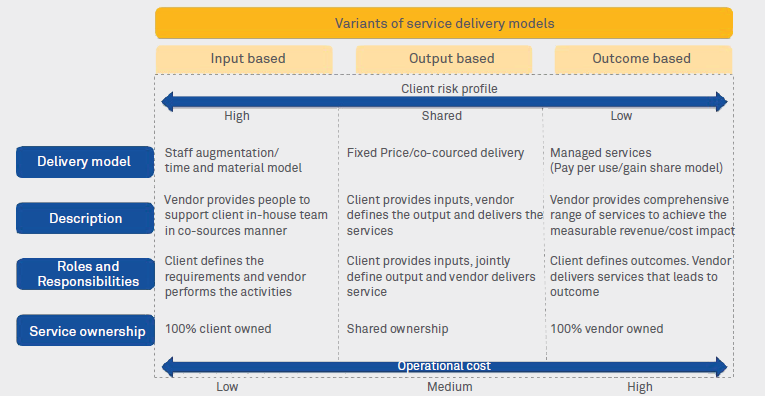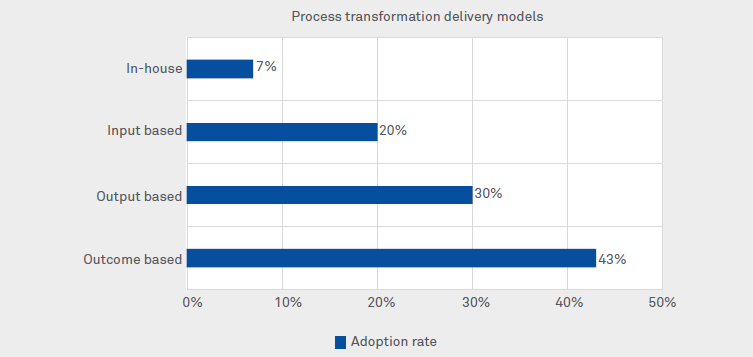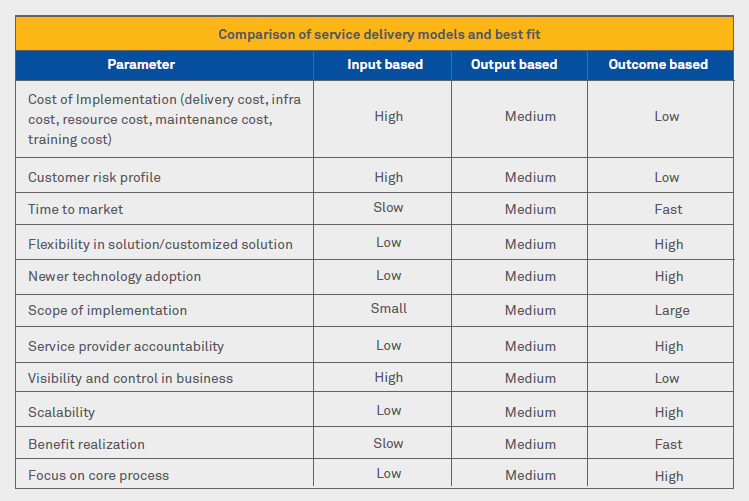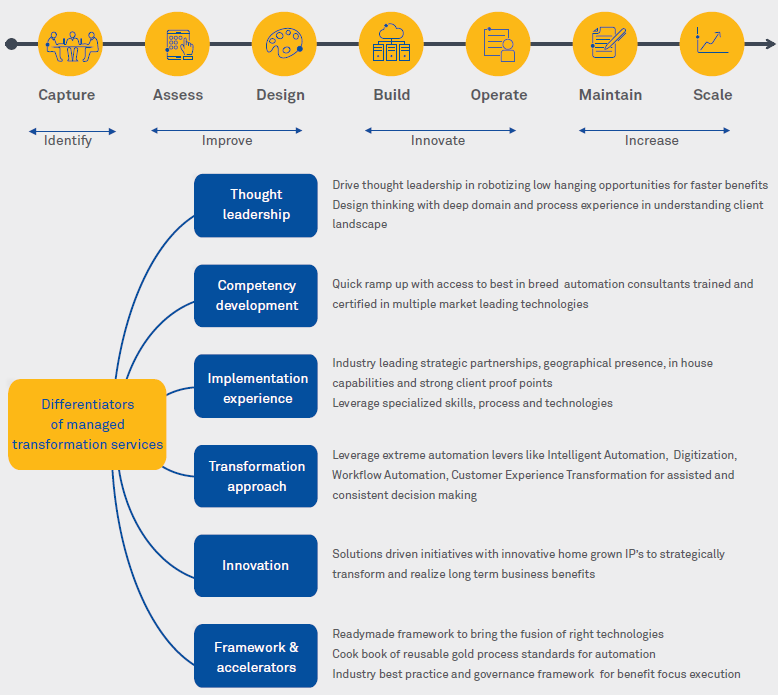November | 2019
This article discusses :
Business process transformation is the buzzword being discussed in every boardroom. It is aimed at reshaping an organizations outdated processes into a robust business model for long term benefits. According to Gartner, eighty-seven percent1 of senior business leaders callout process transformation as their company’s priority. As per Zinnov market study2, automation is recognized as the mainstream for transformation with a growth potential from $2.3 Bn in FY 2019 to $11 Bn in 2024, at a CAGR of thirty five to forty percent. Despite the hype around automation transformation trends, organizations recorded that adoption rate is dawdling with two out of three3 transformational initiatives being unsuccessful or not meeting revenue expectations from digital efforts.
Changing times from input to output to outcome-based services
With process transformation as the need of the hour, organizations are taking rapid but staggered implementation approach across the business functions with disparate automation platforms and solutions from multiple vendors. Some organizations have taken a lead to manage this internally by starting from scratch building an in-house team, setting up practices/policies, investing in software/ hardware infrastructure and maintenance. In a complex scenario of implementation with multi-vendor ecosystem, organizations face continuous challenges in measuring outcomes and managing risks that impact the pace and extent of automation adoption. Accounting for multiple challenges, the secret mantra for successful transformation program lies in the realm of augmenting right implementation model for maximized value at lower cost and risk.
Over the past decade4, outsourcing industry has seen a significant evolution in service delivery models with the value proposition shifted from cost to delivering business outcomes where the perspective of outcome depends on CXO’s vantage point. The variants of service delivery models that have evolved and are widespread in the industry are described below (Figure 1).

Figure 1: Variants of service delivery models

Figure 2: Adoption rate of process transformation delivery models

Figure 3: Comparison of service delivery models
In the process of transition or adoption of delivery models towards managed transformation, organizations should be open to bolder, broader and cohesive enterprise wide initiatives as the benefits of a digital workforce should be evaluated across the whole organization, not just in functional silos. Most companies now seem to be recognizing this.
Approach towards managed transformative services
In the beginning, managed services was created primarily to support infrastructure support. In today’s competitive world with the growing need for disruptive technologies, managed service provides end- to-end cutting-edge solutions that help to make a major impact in all areas of the business, including output and revenue. The key differentiating factor of managed transformation implementation is the unified actionable framework, which leverages multiple technologies and solution levers, such as ‘Simplification’, ‘Automation’, ‘Intelligence’, and ‘Immersive Experience’ for accelerated time to value and ultimate scalability.
Managed services framework follows a matured seven step approach methodology (Figure 4), which is derived based on the in-depth experience gained from multitude of process automation & transformation engagements. The approach methodology breaks down the delivery activities into seven dimensions aligning to the core mantra of Identify, Improve, Innovate and Increase. By embracing managed transformation framework, organizations are enabled to operationalize the whole nine yards of implementation attributes that offer the customers measurable and time bound outcomes with better control and transparency.

Figure 4: Transformation approach methodology
Experimentation to transformation: A path forward with managed services
Many organizations that had started process transformation by treating it as an experiment are now facing challenges in realizing benefit expectations with a staggered and a piloting approach. Maximizing the impact of automation requires a committed shift in mindset and an approach from experimentation to enterprise wide transformation.
To fully harness the potential of process automation and transformation, organizations are recommended to gauge managed services that will not only deliver straight forward business benefits with high levels of experience driven operational integration and scalability, but also let organizations to focus on their top strategic priorities, such as core business growth, design thinking, and value creations.
References
Sanyog Chaudhry
Digital Operations & Platforms, Enterprise Operations Transformation, Wipro
Sanyog is a seasoned digital and transformation experience leader with 12 years of rich exposure and is responsible for creating operational transformation solutions for CXO level clients across multiple industries. Sanyog leads consulting assignments for scoping and delivery of transformational programs along with engaging with the sales and consulting teams on the transformation offerings suite.
Theepika Devaraj
Digital Operations & Platforms, Enterprise Operations Transformation, Wipro
Theepika is a proficient business process transformation professional with an emergent technology exposure in RPA, AI and Digital Platforms. She has 6 years of industry experience in leading several large and successful client engagements with diversified exposure in discovering opportunities, defining roadmap and developing holistic solutions, thus bringing an improved business benefits and enhanced customer experience.